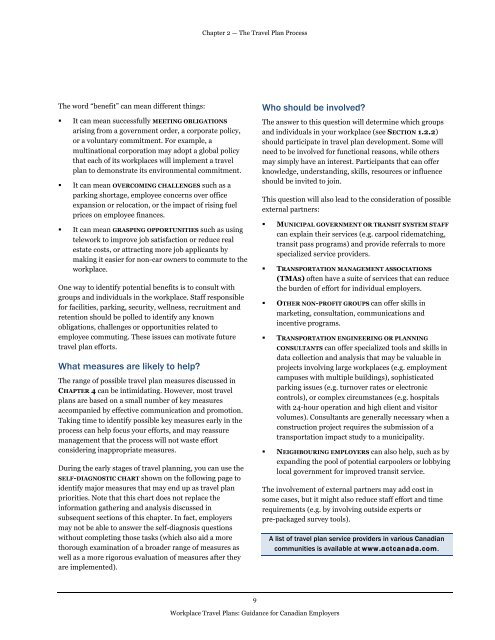Workplace Travel Plans - main body - Final Jan 2010 ENGLISH - FCM
Workplace Travel Plans - main body - Final Jan 2010 ENGLISH - FCM
Workplace Travel Plans - main body - Final Jan 2010 ENGLISH - FCM
Create successful ePaper yourself
Turn your PDF publications into a flip-book with our unique Google optimized e-Paper software.
Chapter 2 — The <strong>Travel</strong> Plan Process<br />
The word “benefit” can mean different things:<br />
! It can mean successfully MEETING OBLIGATIONS<br />
arising from a government order, a corporate policy,<br />
or a voluntary commitment. For example, a<br />
multinational corporation may adopt a global policy<br />
that each of its workplaces will implement a travel<br />
plan to demonstrate its environmental commitment.<br />
! It can mean OVERCOMING CHALLENGES such as a<br />
parking shortage, employee concerns over office<br />
expansion or relocation, or the impact of rising fuel<br />
prices on employee finances.<br />
! It can mean GRASPING OPPORTUNITIES such as using<br />
telework to improve job satisfaction or reduce real<br />
estate costs, or attracting more job applicants by<br />
making it easier for non-car owners to commute to the<br />
workplace.<br />
One way to identify potential benefits is to consult with<br />
groups and individuals in the workplace. Staff responsible<br />
for facilities, parking, security, wellness, recruitment and<br />
retention should be polled to identify any known<br />
obligations, challenges or opportunities related to<br />
employee commuting. These issues can motivate future<br />
travel plan efforts.<br />
What measures are likely to help?<br />
The range of possible travel plan measures discussed in<br />
CHAPTER 4 can be intimidating. However, most travel<br />
plans are based on a small number of key measures<br />
accompanied by effective communication and promotion.<br />
Taking time to identify possible key measures early in the<br />
process can help focus your efforts, and may reassure<br />
management that the process will not waste effort<br />
considering inappropriate measures.<br />
During the early stages of travel planning, you can use the<br />
SELF-DIAGNOSTIC CHART shown on the following page to<br />
identify major measures that may end up as travel plan<br />
priorities. Note that this chart does not replace the<br />
information gathering and analysis discussed in<br />
subsequent sections of this chapter. In fact, employers<br />
may not be able to answer the self-diagnosis questions<br />
without completing those tasks (which also aid a more<br />
thorough examination of a broader range of measures as<br />
well as a more rigorous evaluation of measures after they<br />
are implemented).<br />
Who should be involved?<br />
The answer to this question will determine which groups<br />
and individuals in your workplace (see SECTION 1.2.2)<br />
should participate in travel plan development. Some will<br />
need to be involved for functional reasons, while others<br />
may simply have an interest. Participants that can offer<br />
knowledge, understanding, skills, resources or influence<br />
should be invited to join.<br />
This question will also lead to the consideration of possible<br />
external partners:<br />
! MUNICIPAL GOVERNMENT OR TRANSIT SYSTEM STAFF<br />
can explain their services (e.g. carpool ridematching,<br />
transit pass programs) and provide referrals to more<br />
specialized service providers.<br />
! TRANSPORTATION MANAGEMENT ASSOCIATIONS<br />
(TMAS) often have a suite of services that can reduce<br />
the burden of effort for individual employers.<br />
! OTHER NON-PROFIT GROUPS can offer skills in<br />
marketing, consultation, communications and<br />
incentive programs.<br />
! TRANSPORTATION ENGINEERING OR PLANNING<br />
CONSULTANTS can offer specialized tools and skills in<br />
data collection and analysis that may be valuable in<br />
projects involving large workplaces (e.g. employment<br />
campuses with multiple buildings), sophisticated<br />
parking issues (e.g. turnover rates or electronic<br />
controls), or complex circumstances (e.g. hospitals<br />
with 24-hour operation and high client and visitor<br />
volumes). Consultants are generally necessary when a<br />
construction project requires the submission of a<br />
transportation impact study to a municipality.<br />
! NEIGHBOURING EMPLOYERS can also help, such as by<br />
expanding the pool of potential carpoolers or lobbying<br />
local government for improved transit service.<br />
The involvement of external partners may add cost in<br />
some cases, but it might also reduce staff effort and time<br />
requirements (e.g. by involving outside experts or<br />
pre-packaged survey tools).<br />
A list of travel plan service providers in various Canadian<br />
communities is available at www.actcanada.com.<br />
9<br />
<strong>Workplace</strong> <strong>Travel</strong> <strong>Plans</strong>: Guidance for Canadian Employers

















